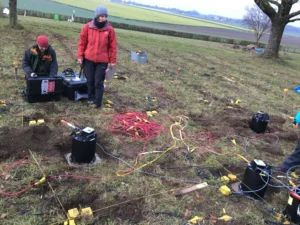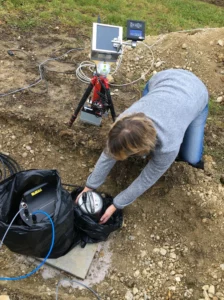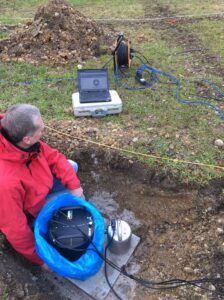- Photonics & Space
Fürstenfeldbruck, Germany | November, 2019


The iXblue’ team conducts many evaluation missions, over the world in collaboration with partners, to demonstrate the blueSeis’s measurement capabilities on seismology and volcanology, ground tomography, infrastructure monitoring and so on. One field mission was organized and hosted by Ludwig Maximilian University:
One of the greatest temporary demo in rotational seismology took place in München
During 6 months, a lot of seismic sensors, of different kind, are collocated to record rotational and translational waves.
Active sources are used as seismic signals : more than 12 explosions and one full day of vibro truck.
Then, high sensitivity sensors will keep in place for months to catch distant seisms.
Several products from iXblue took part to this experiment:
- 8 blueSeis-3A
- 6 quadrans
- 1 octans
- 2 phins
This demo gathers 42 scientists from 10 international teams.
From validation of sensors performances to insight into 6C computation and research on improvement in inversion, this experiment will be a major milestone in this hot topic.
 |
 |
 |
Publications:
Multiple 6C-station Huddle Test in Fürstenfeldbruck, Germany
Gizem Izgi1, Stefanie Donner3, Felix Bernauer2, Daniel Vollmer1, Klaus Stammler3, Mathias Hoffmann3, and Eva P.S. Eibl1
- Institute of Geosciences, University of Potsdam, Karl-Liebknecht-Str. 24, 14476 Potsdam, Germany (gizem.izgi@uni-potsdam.de)
- Geophysical Observatory Fürstenfeldbruck, Ludwigshöhe 8, 82256 Fürstenfelbruck, Germany
- BGR Federal Institute for Geosciences and Natural Resources, Stilleweg 2, 30655 Hannover, Germany
Rotational motions play a key role in measuring seismic wavefield properties. To fully understand and describe the behavior of seismic waves, both translational and rotational components should be properly investigated. Portable blueSeis-3A (iXblue) sensors allow to measure 3 components of rotational motions with high sensitivity in a frequency range from 0.001 Hz to 50 Hz.
A huddle test was performed in Fürstenfeldbruck, Germany by the University of Potsdam in collaboration with the Ludwig-Maximilians University of Munich (LMU) and Federal Institute for Geosciences and Natural Resources (BGR) between 26 of August and 02 of September 2019, in order to further investigate the performance of multiple rotational instruments in combination with seismometers. Within the scope of this test, 5 rotational and 3 translational sensors were deployed on the basement of the observatory on decoupled plinth. Our preliminary results show good correlation between all components and rotational sensors. To investigate the coherent noise between sensors, we applied a 50 Hz low-pass filter and 100 Hz sampling rate. To better illustrate, probabilistic power spectral densities and spectrograms have been created. In general, we will discuss the reliability of the data recorded by rotational sensors for further investigations.
https://meetingorganizer.copernicus.org/EGU2020/EGU2020-5602.html


